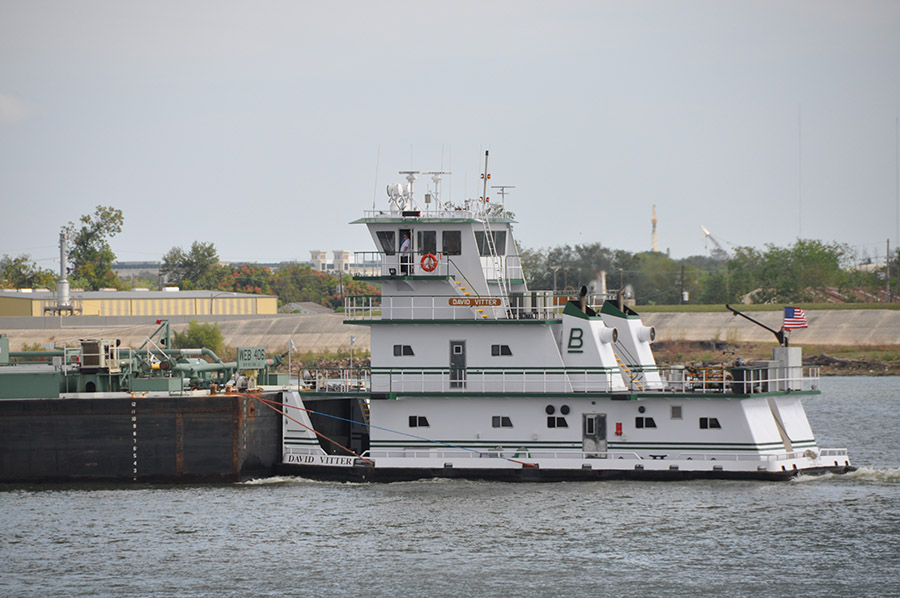Cummins’ new hybrid system offers an alternative to SCR exhaust aftertreatment
Lets say that you’re an inland waterways towboat operator that wants to build a new boat in a couple of years, and you’re looking at powering the boat with engines in the 1,000-hp range.
There’s never been an emissions issue with these sized engines before, but beginning in 2017, a 1,000-hp engine presents a problem because of EPA Tier 4 regulations. For engines over 804 hp, the new Tier 4 emissions rules will take effect Jan. 1. So, sticking with a 1,000-hp engine will likely mean matching it up with a urea-based selective catalytic reduction (SCR) exhaust aftertreatment system.
That SCR system will take up space, add weight, and be more complicated than most operators want. Are there any alternatives other than SCR? Well, if you were at the International WorkBoat Show in December and stopped by the Cummins booth, you might have heard about one.
THE HYBRID OPTION
The company’s hybrid variable-speed diesel-electric system matches up Cummins engines and a generator with controllers — an AC traction motor and a power management system from BAE Systems, and batteries from Corvus Energy. A likely scenario would be a Cummins QSK19 at about 750 or 800 hp with a power take in on the marine gear that receives power from the electric motor to make up the difference between the QSK19’s horsepower and the needed 1,000 hp.
The hybrid notion comes in when the QSK19 is matched up with the BAE components and a Cummins QSB7 diesel with a variable-speed generator that would “develop 200-kW power to charge the batteries and/or to provide power to the electric motor,” said Frank Ruggiero, who leads the applications and engineering group at Cummins for the marine oil and gas divisions. Combine the output from the QSK19 and the QSB7-powered generator and 1,000 hp is delivered to the shaft.
Cummins sees this combination as particularly fitting for inland pushboats which spend about “25 percent of the time at idle or full on and the rest of the time, somewhere in between at an operating power of about 750 hp,” Ruggiero said.
Thus when a pushboat is running at idle it can get by on batteries alone or batteries and the variable-speed generator to supply power to the electric motor. That, said Ruggiero, would “minimize emissions because you are only running on a 7-liter engine rather than a 38-liter engine, which historically you would use for those times below 25 percent load.”
The QSK19 by itself would be adequate when running barges because you only need about 700 hp, Ruggiero said. When the full 1,000 hp is called for, the electric motor comes on line with power from the batteries and the QSB7’s variable-speed generator.
Basically, the Cummins system provides three different modes of operation: batteries only, diesel power only, or diesel and electric together on the same shaft.
Another advantage to the Cummins-BAE power management system is that it can provide house power as well as power to deck equipment such as electric winches.

Ruggiero contrasts the Cummins option with the only other way to avoid installing SCR emission systems in a pushboat. That would be three engines less than 804 hp with three shafts. But with that arrangement, “you lose all that power on the wings for maneuvering,” he said. “Operators don’t have the turning force they used to have.”
As for the cost compared to a conventional engine power arrangement, Ruggiero figures it’s about a 20% hit upfront to install the system. However, he said an operator could recover that within the first year in just fuel savings alone. Plus, maintenance costs should be less with two relatively small engines that aren’t running full time as opposed to a large engine.
Savings for “the total cost of ownership” is about $10,000 over a 10-year period, said Ruggiero. From an environmental standpoint, use of a smaller engine with the variable-speed generator, carbon emissions would be 200 to 250 tons less than with a conventional operation. The Cummins hybrid variable-speed diesel-electric system shouldn’t present much of a learning curve for a boat’s engineer, Ruggiero said. The BAE components are modular and self-diagnostic, alerting you when there’s an issue. “It’s more of a paradigm shift, as in ‘I’m used to having diesels, so why do I have to have batteries and all this other hardware?’ ”

Cummins hybrid-assist system.
The variable speed diesel-electric solution is not new. Versions of it are used in locomotives, linehaul trucks, and Cummins and BAE have partnered in powering about 7,000 buses with a parallel hybrid system. But it is new to the marine world. Ruggiero said he’s not aware of another company that offers a similar hybrid system.
At the WorkBoat Show, Cummins representatives spent a fair amount of time explaining the hybrid variable-speed diesel-electric system to several customers, including one interested in a 1,000-hp pushboat and another considering a 1,200-hp harbor service vessel.
It wouldn’t be a problem matching the Cummins hybrid system and the QSK19 up with 1,200-hp since BAE offers “the same electric motor from 100 kW to 300 kW, so I can supplement up to 420 hp,” said Ruggiero. Now, all that’s needed is for someone to sign on the dotted line.




